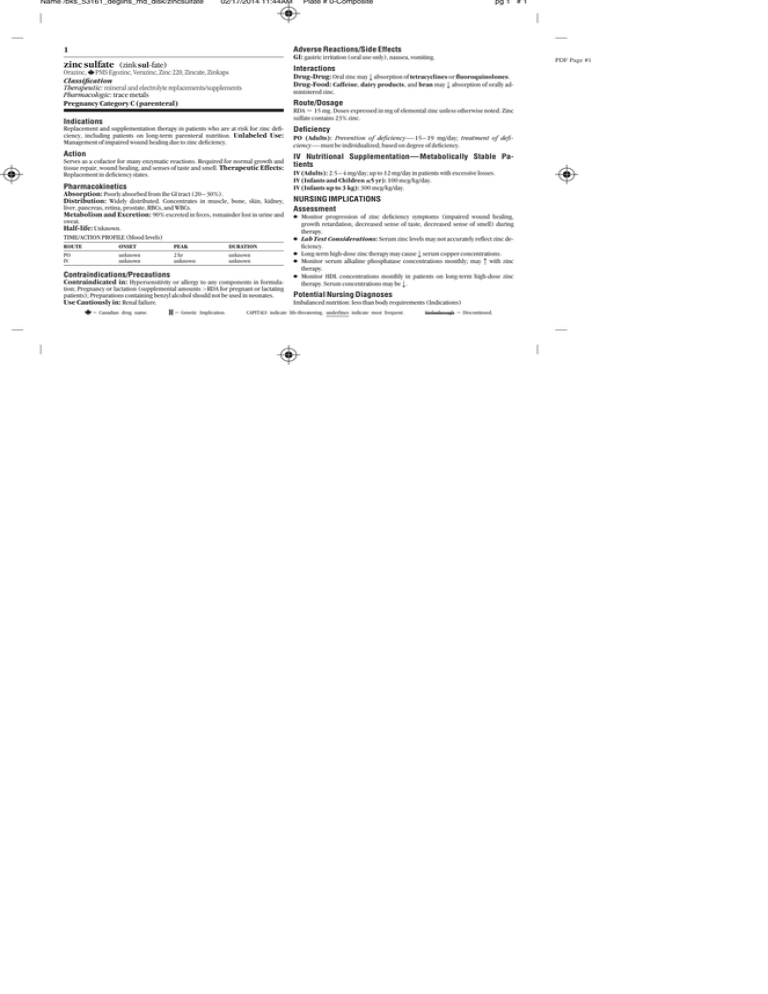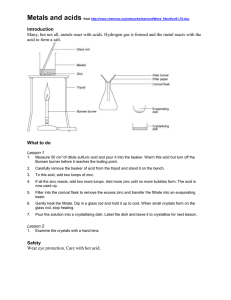zinc sulfate (zinksul-fate) - DavisPlus
advertisement

Name /bks_53161_deglins_md_disk/zincsulfate 02/17/2014 11:44AM Plate # 0-Composite pg 1 # 1 Adverse Reactions/Side Effects GI: gastric irritation (oral use only), nausea, vomiting. 1 zinc sulfate (zink sul-fate) Interactions Drug-Drug: Oral zinc maypabsorption of tetracyclines or fluoroquinolones. Drug-Food: Caffeine, dairy products, and bran maypabsorption of orally ad- Orazinc, PMS Egozinc, Verazinc, Zinc 220, Zincate, Zinkaps Classification Therapeutic: mineral and electrolyte replacements/supplements Pharmacologic: trace metals Pregnancy Category C (parenteral) ministered zinc. Route/Dosage RDA ⫽ 15 mg. Doses expressed in mg of elemental zinc unless otherwise noted. Zinc sulfate contains 23% zinc. Indications Replacement and supplementation therapy in patients who are at risk for zinc deficiency, including patients on long-term parenteral nutrition. Unlabeled Use: Management of impaired wound healing due to zinc deficiency. Deficiency Action IV Nutritional Supplementation—Metabolically Stable Patients Serves as a cofactor for many enzymatic reactions. Required for normal growth and tissue repair, wound healing, and senses of taste and smell. Therapeutic Effects: Replacement in deficiency states. Pharmacokinetics Absorption: Poorly absorbed from the GI tract (20– 30%). Distribution: Widely distributed. Concentrates in muscle, bone, skin, kidney, liver, pancreas, retina, prostate, RBCs, and WBCs. Metabolism and Excretion: 90% excreted in feces, remainder lost in urine and sweat. Half-life: Unknown. TIME/ACTION PROFILE (blood levels) ROUTE PO IV ONSET unknown unknown PEAK 2 hr unknown DURATION unknown unknown PO (Adults): Prevention of deficiency— 15– 19 mg/day; treatment of deficiency— must be individualized; based on degree of deficiency. IV (Adults): 2.5– 4 mg/day; up to 12 mg/day in patients with excessive losses. IV (Infants and Children ⱕ5 yr): 100 mcg/kg/day. IV (Infants up to 3 kg): 300 mcg/kg/day. NURSING IMPLICATIONS Assessment ● Monitor progression of zinc deficiency symptoms (impaired wound healing, ● ● ● growth retardation, decreased sense of taste, decreased sense of smell) during therapy. Lab Test Considerations: Serum zinc levels may not accurately reflect zinc deficiency. Long-term high-dose zinc therapy may causepserum copper concentrations. Monitor serum alkaline phosphatase concentrations monthly; mayqwith zinc therapy. Monitor HDL concentrations monthly in patients on long-term high-dose zinc therapy. Serum concentrations may bep. Contraindications/Precautions Contraindicated in: Hypersensitivity or allergy to any components in formula- ● tion; Pregnancy or lactation (supplemental amounts ⬎RDA for pregnant or lactating patients); Preparations containing benzyl alcohol should not be used in neonates. Use Cautiously in: Renal failure. Potential Nursing Diagnoses ⫽ Canadian drug name. ⫽ Genetic Implication. Imbalanced nutrition: less than body requirements (Indications) CAPITALS indicate life-threatening, underlines indicate most frequent. Strikethrough ⫽ Discontinued. PDF Page #1 Name /bks_53161_deglins_md_disk/zincsulfate 02/17/2014 11:44AM Plate # 0-Composite pg 2 # 2 2 PDF Page #2 Implementation ● PO: Administer oral doses with food to decrease gastric irritation. Administration with caffeine, dairy products, or bran may impair absorption. ● IV: Zinc is often included as a trace mineral in total parenteral nutrition solution prepared by pharmacist. Patient/Family Teaching ● Encourage patient to comply with diet recommendations of health care profes- sional. Explain that the best source of vitamins is a well-balanced diet with foods from the four basic food groups. Foods high in zinc include seafood, organ meats, and wheat germ. ● Patients self-medicating with vitamin supplements should be cautioned not to exceed RDA. The effectiveness of megadoses for treatment of various medical conditions is unproved and may cause side effects. ● Instruct patients receiving oral zinc to notify health care professional if severe nausea or vomiting, abdominal pain, or tarry stools occur. ● Emphasize the importance of follow-up exams to evaluate progress. Evaluation/Desired Outcomes ● Improved wound healing. ● Improved senses of taste or smell. 6– 8 wk of therapy may be required before full effect is seen. Why was this drug prescribed for your patient? 䉷 2015 F.A. Davis Company



